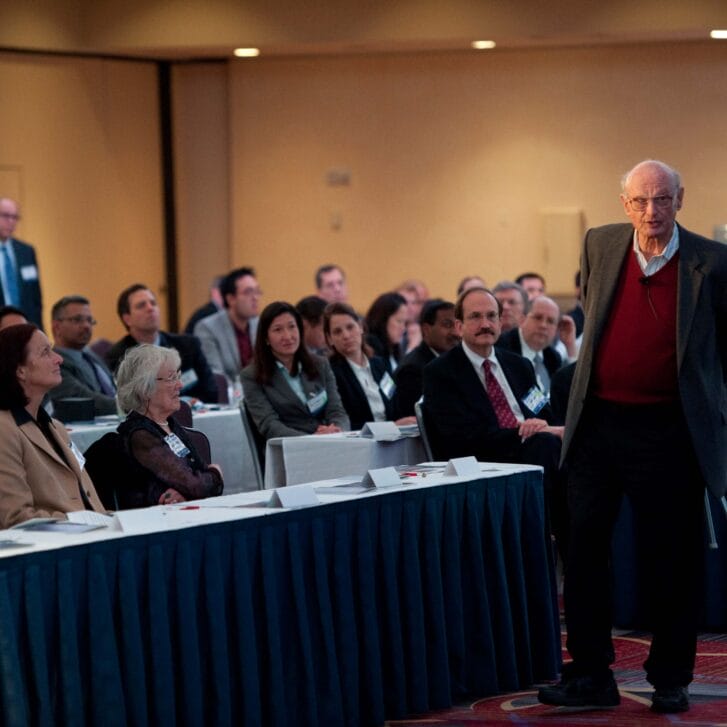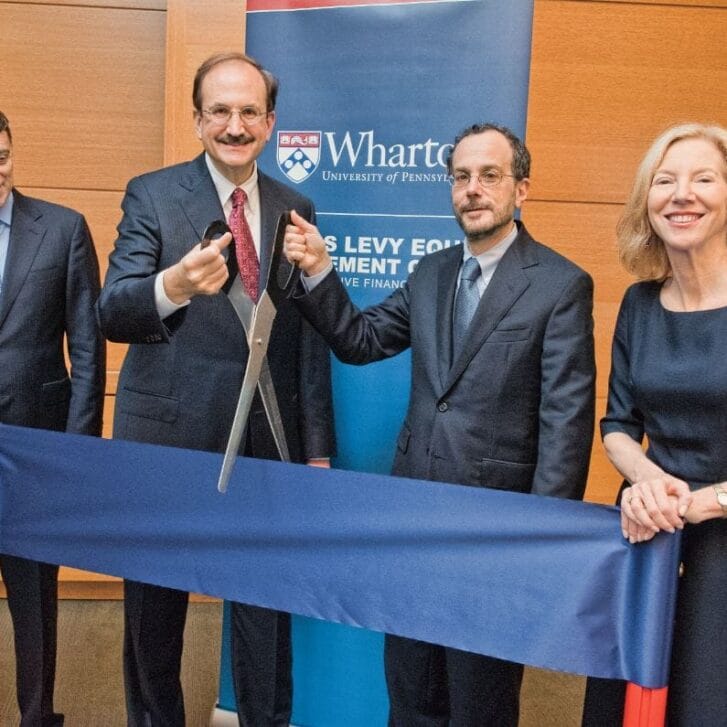Slivy Edmonds, WG’79: Making Deals
Slivy Edmonds recognizes that Tucson, Ariz., isn’t the ideal location for a leveraged buyout firm. “The biggest problem is airline transportation,” she says. “You can’t get anyplace from Tucson without going through Dallas or Phoenix.”
Edmonds expects her travel schedule to heat up in the coming year as she takes to the road to raise money — somewhere in the $200 million range — for an investment partnership. The fund will be in addition to Walnut Capital Corp., a private investment firm she and a partner started up in 1994 with their own assets. “In this business you spend most of your time looking for opportunities,” she says.
And finding them, she might add. She started her business career as an analyst at Bristol-Myers Squibb in 1979, then moved in 1981 to the corporate finance department at Equitable Capital Investment Management in New York.
“The company was just then starting to change its very stodgy image and begin competing aggressively within the financial markets,” says Edmonds. “Those of us with experience, who felt we were up to the competition, had opportunities to do a lot within a short period of time.”
In 1986 she left to work for one of Equitable’s portfolio companies, a startup airline called Air Atlanta. Edmonds served as CFO for 11 months before it was decided to put the company into bankruptcy.
In 1987, she and two associates formed an investment leveraged buyout firm in Washington D.C. called Georgetown Partners. Their goal was to invest in entrepreneurs and/or minority-run companies that looked promising but would have trouble getting access to the capital markets.
In what would turn out to be one of those classic examples of unforeseeable bad timing, the company also formed an alliance with Drexel Burnham Lambert. Drexel Burnham in 1988 was interested in becoming a prime source of debt capital for minority entrepreneurs. It agreed to commit $100 million in financing to Georgetown Partners.
“We started to look for deals,” says Edmonds. “In 1990, four days after we had submitted a letter of intent to buy a company, Drexel Burnham was out of business. The capital disappeared overnight. It was the end of everything we had set out to do.”
Edmonds and one of her two partners made a crucial decision. “We decided the best way to show that you could make money investing in minority entrepreneurs was to go out and do a deal for our own account. It meant that when we went back to the marketplace we would be talking from the standpoint of experience, of having a track record of our own.”
In 1990, Edmonds and her partner bought, and helped run, Hamilton Test Systems, Inc., the number two firm in the auto emissions testing industry. With pending changes in the 1990 Clean Air Act, Edmonds saw the company as a chance to get into a potentially high-growth industry. Two years later, Georgetown Partners acquired the number one company in the industry and merged the two together.
One year later, newly-merged Envirotest Systems Corp. went public with an IPO of $50 million in equity and $125 million in debt. “It worked out very well,” says Edmonds. “As a result of that deal, there were a number of first-time, minority-run, leveraged buyout funds that got capital. We were pioneers in proving that the best way to increase the flow of capital to minority businesses is to show that these businesses can achieve superior returns.” Harvard Business School did a case study on Envirotest Systems in 1994, and invited Edmonds to participate in the presentation.
Edmonds left the company in January 1994, but decided to stay in Tucson, where she had spent three years at the headquarters of Hamilton Test Systems. In Tucson, she was an early supporter and member of a women’s fund to help target more money to women’s social and health issues.
She grew up in Norfolk, Va., and earned a nursing degree from Medical College of Pennsylvania before getting her undergraduate degree in business management from Marymount College.
Edmonds, 48, has always been a resource for minority businesspeople. She is a member of a group called Capital Circle, formed specifically to increase the flow of capital to women’s businesses; and the National Association of Investment Managers, whose mission is to increase capital to minority groups.
“Much of the work I have done has been within corporate America, making sure opportunities that were presented by minorities were evaluated and looked at on the same basis as other opportunities.
“I have a found a lot of very talented minority entrepreneurs whose biggest problem is figuring out how you get access to decision makers at the highest levels. The main obstacle is getting in the door.”
Mauricio F. Vives, WG’84: Graffiti Takes Off
Watt’s, a Chilean manufacturer of fruit juices, marmalades and ketchup, recently began selling an orange juice with extra calcium. To publicize the new product, the company’s ad agency came up with a two-page spread showing a glass with water and dentures on the left page, and a glass with the new calcium-fortified juice on the right page.
 The text, loosely translated, reads: If you don’t want to see this glass [with the dentures] on your night table, you better start seeing this glass [with the juice] on your breakfast table.
The text, loosely translated, reads: If you don’t want to see this glass [with the dentures] on your night table, you better start seeing this glass [with the juice] on your breakfast table.
The ad comes courtesy of Graffiti, a Santiago agency that recently celebrated its first birthday and is already the 12th largest agency in the country and the third largest Chilean-owned agency. Its president and majority owner is Mauricio Vives, a 37-year-old businessman with a nose for new markets.
Example: During a trip to Boston one weekend while he was working for Procter & Gamble in Cincinnati, Vives came across a coupon for a P&G product that was written in Spanish and contained numerous typographical errors. Back in Cincinnati Vives typed a memo loaded with typos to his supervisor.
The boss got the message, and soon after asked Vives to help with the company’s first serious effort at selling products to the Hispanic market.
Within a year Vives was named the Hispanic marketing brand manager. Over the course of three years, he convinced P&G to let his group handle several different products, rather than the customary one, but only in areas where there was a sizeable Hispanic population. Vives also asked the company to allocate a portion of its existing advertising budget to the Hispanic marketing group, and suggested that P&G’s ad agencies affiliate themselves with Hispanic agencies. “So you had a group thinking about Hispanic business, with money to support the effort, and with ad agencies to help promote the products,” Vives says.
Vives left P&G in 1989 when the opportunity came to open a Unisys microcomputer distributorship in Chile. A year later he moved back to the U.S. to work for an Hispanic ad agency owned by Grey Advertising.
Vives was then approached by Young & Rubicam — with billings of more than $8 billion and offices in 64 countries — to turn around its Chilean subsidiary, which at that time was one of Y&R’s least successful foreign operations.
Vives suggested as one option that Y&R merge its current office with an existing top-ten agency in Santiago. What eventually happened was this:
Y&R bought a top-ten agency which is now called Prolam/YR, and sold its old office to Vives. Vives kept not only the office space and furniture but also the staff. Prolam/YR took the multinational clients, while the old Y&R, which Vives renamed Graffiti, kept the local clients.
“It was convenient for everyone,” says Vives. “I did what Y&R wanted, which was to put their name among the top 10 agencies, where it belonged; I took over the existing Y&R office, which meant that Y&R didn’t have to fire the staff or pay severance; and I got the opportunity to go out on my own.” The deal was finalized in May 1994.
Graffiti, with its staff of 40, is already profitable, and has 13 different clients, including Lonceleche, a dairy manufacturer; adidas; Pioneer and NEC electronics. About 50 percent of billings are TV ads, although print ads are a close second.
Vives grew up in Chile, spent a year on an AFS exchange program in Doylestown, Pa., and earned an engineering degree from Catholic University in Santiago. He and his wife have four children, ages 3 to 12, and live outside the city.
Vives is not the creative genius behind the company’s ad campaigns, which have already won two of Chile’s top fifteen awards for best TV ads. “One of my partners is the creative director, thank God,” says Vives, who concentrates on the business side and also uses his marketing background to advise clients. “I am a civil engineer by training. If I did the ads they would be full of numbers.”
Bruce A. Stevens, W’64: The Piano Man
Talk about believing in your product. For Bruce Stevens, president of Steinway & Sons, the opportunity to sell Steinway pianos around the world is “like a gift from heaven.”
Rarely in your life, he says, do you get the opportunity “to be involved with a company that is considered an icon throughout the entire world. Few products give you the kind of genuine elation that a Steinway piano does. It’s a thing of beauty.”
That said, what first attracted Stevens to Steinway was the opportunity to turn around a poorly managed company with a lot of potential for improvement. That was back in the mid 1980s when CBS announced it wanted to sell off what had once been a thriving musical division. Stevens, with two partners, formed Steinway Musical Properties and in September 1985 bought from CBS four companies, including Steinway & Sons.
Steinway Musical Properties sold the three other companies several years ago, as had been originally planned, and Stevens now concentrates all his time on Steinway. During his nine years there, he has completely revamped the marketing and distribution networks and made progress improving the manufacturing process, all with an eye to preserving the integrity of the product and the name.
 Much of it comes down to customer service. “We call it the partnership program,” says Stevens, referring to Steinway’s relationship with its 93 domestic and 200 international dealers. These dealers agree to properly present, maintain and service the pianos, not just for the ordinary customer but also for concert artists. In exchange, the company gives these dealers exclusive territories and what Stevens calls “a roadmap to profitability.” This consists of a merchandising philosophy, promotional concepts, and a concert artist program that includes free endorsements from the world’s leading concert artists.
Much of it comes down to customer service. “We call it the partnership program,” says Stevens, referring to Steinway’s relationship with its 93 domestic and 200 international dealers. These dealers agree to properly present, maintain and service the pianos, not just for the ordinary customer but also for concert artists. In exchange, the company gives these dealers exclusive territories and what Stevens calls “a roadmap to profitability.” This consists of a merchandising philosophy, promotional concepts, and a concert artist program that includes free endorsements from the world’s leading concert artists.
“We ask a lot of our dealers, but in turn they ask and expect an awful lot from us,” says Stevens.
Steinway pianos range in price from $11,900 to $17,400 for vertical uprights, and from $26,400 to $75,800 for grand pianos. More than 90 percent of professional pianists play on a Steinway.
In April, Steinway & Sons was acquired for $100 million by the Selmer Company, a maker of band and orchestral instruments based in Elkhart, Ind. Under the terms of the transaction, Selmer and Steinway will continue to operate as independent entities, with no changes in management, plant locations, marketing strategy or employment levels.
Stevens, 52, grew up in Shenandoah, Iowa, and attended Iowa State University for two years before transferring to Wharton. He worked for Armstrong Cork Co. in Lancaster, Pa., for one year after graduation, and then moved to Polaroid Corp. in Cambridge, Mass., where he stayed 18 years. Twelve of those years were spent in the U.S. and the last six in the international arena, including three years in Tokyo where he ran Polaroid’s Japanese subsidiary and was in charge of all other Asia-Pacific subsidiaries.
Stevens is married, has two daughters ages 18 and 16, and lives in Winchester, Mass., when he’s not traveling.
About five times a year, he checks in on Steinway dealers in Europe as well as the company’s manufacturing plant in Hamburg, Germany. He also spends several days of most weeks at the company’s other plant in Long Island City, N.Y. Company headquarters are in Waltham, Mass.
What little time he has for recreation is devoted to sports — bike riding, skiing, tennis and golf. He is not a piano player. “But we did have a Steinway when I was growing up,” he says. “There has always been music in my family.”

























